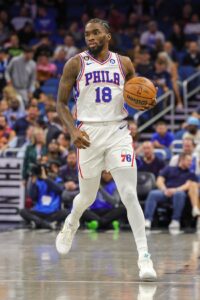For the rest of the regular season and postseason, Hoops Rumors is taking a closer look at players who will be free agents or could become free agents during the 2024 offseason. We consider whether their stock is rising or falling due to their performance and other factors. Today, we’re focusing on a handful of players from the Central Division.
Patrick Williams, F, Bulls
- 2023/24: $9,835,881
- 2024/25: RFA
- Stock: Neutral
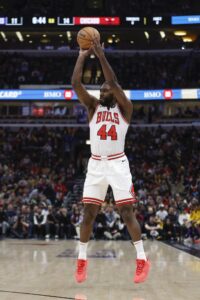 The Bulls are in a tricky spot with Williams, whose season ended early when it was announced in February that he would undergo foot surgery that would sideline him for the remainder of ’23/24. He’ll be a restricted free agent if Chicago gives him a $12.97MM qualifying offer, which should be a lock.
The Bulls are in a tricky spot with Williams, whose season ended early when it was announced in February that he would undergo foot surgery that would sideline him for the remainder of ’23/24. He’ll be a restricted free agent if Chicago gives him a $12.97MM qualifying offer, which should be a lock.
Still just 22 years old, Williams is a former No. 4 overall pick who has shown glimpses of tantalizing two-way upside over his first four seasons. The problem is, those glimpses have been fleeting and have never been sustained for a prolonged period of time.
In fairness to Williams, injuries have certainly played a role in his up-and-down play — while he played 71 games as a rookie and all 82 games in 2022/23, he was limited to just 17 games in ’21/22 due to a wrist injury and only made 43 appearances this season due to foot and ankle issues.
I’m sure the Bulls would have loved for Williams to have a breakout season in ’23/24 and cement his place as a cornerstone to build around going forward. But his averages — 10.0 PPG, 3.9 RPG, 0.9 SPG and 0.8 BPG on .443/.399/.788 shooting in 43 games (27.3 MPG) — were basically in line with his career numbers. Not better or worse, just neutral.
Williams has a high ceiling on both ends of the court due to his size, length, athleticism and skills. His production hasn’t matched his talent level to this point though, and there are a wide range of outcomes for what his next contract could look like, depending on how much external interest he draws as a RFA.
Isaac Okoro, G/F, Cavaliers
- 2023/24: $8,920,795
- 2024/25: RFA
- Stock: Up
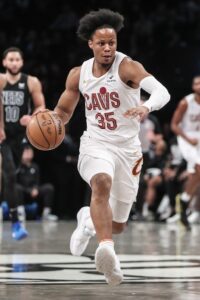 Okoro was selected with the No. 5 overall pick in 2020 — right after Williams. And as with Williams, Okoro showed glimpses of being a productive rotation regular for Cleveland during his first three seasons.
Okoro was selected with the No. 5 overall pick in 2020 — right after Williams. And as with Williams, Okoro showed glimpses of being a productive rotation regular for Cleveland during his first three seasons.
So why is Okoro’s stock up and Williams’ stuck in neutral? The answer is subjective of course, but part of it has to do with expectations.
After playing a career-low 21.7 minutes per game last season, Okoro is up to 27.2 MPG in ’23/24, and he has played well both as a starter and as a reserve. Overall, he’s averaging 9.7 PPG, 3.2 RPG, 2.0 APG and 0.9 SPG on .498/.399/.686 shooting in 57 games, including 34 starts.
The 23-year-old has improved in the area most critical to his development: three-point shooting. His 39.9% mark from deep is a career high, and he’s Cleveland’s best perimeter defender.
Like Williams, Okoro will be a restricted free agent in the offseason if he’s tendered a qualifying offer. Given the Cavs’ salary cap situation, I don’t expect him to receive much more than the mid-level exception, which is projected to be worth about $13.8MM annually on a four-year deal.
Okoro’s future with Cleveland was looking a little shaky last summer after the team acquired Max Strus and re-signed Caris LeVert. But he has become more decisive and effective on offense on top of being an already-strong defender, and I’d be very surprised if the Cavs didn’t keep him around in the offseason.
Jae Crowder, F, Bucks
- 2023/24: $3,196,448 (minimum salary; $2,019,706 cap hit)
- 2024/25: UFA
- Stock: Down
Now in his 12th NBA season, Crowder has far exceeded the careers of most second-round picks (he was selected No. 34 overall back in 2012). But he also appears to be at the tail end of his career.
The 33-year-old’s lengthy holdout with Phoenix last season was one of the more bizarre decisions for a player who was about to become a free agent. He was eventually moved to Milwaukee — his preferred destination — but at a significant cost: he made $10.2MM in ’22/23, and re-signed with the Bucks on a one-year, minimum-salary contract last summer.
Crowder hasn’t shown anything this year to prove he’s worth more than the veteran’s minimum going forward, averaging 6.1 PPG and 3.4 RPG on .421/.353/.692 shooting. He has only appeared 36 games (23.8 MPG), having missed 31 games early in the season after suffering a left adductor and abdominal tear, which required surgery.
Perhaps things will change if Crowder has a strong playoff performance, but to my eyes, he’s at least a half-step slower on defense than he used to be, and that was always his calling card. At his age, it’s rare for that trend to reverse.
Jalen Smith, F/C, Pacers
- 2023/24: $5,043,773
- 2024/25: $5,417,386 player option
- Stock: Up
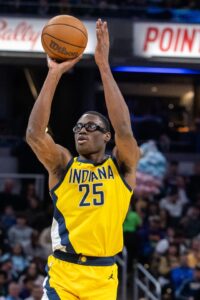 Smith, who turns 24 years old today (happy birthday), is actually the third former lottery pick from 2020 on this list, as he was selected No. 10 overall in the same draft as Williams and Okoro. However, he has had a much different NBA path than his fellow draftees.
Smith, who turns 24 years old today (happy birthday), is actually the third former lottery pick from 2020 on this list, as he was selected No. 10 overall in the same draft as Williams and Okoro. However, he has had a much different NBA path than his fellow draftees.
Smith didn’t play much for the team that selected him, Phoenix, and the Suns declined their third-year team option on his rookie scale contract in 2021. He was traded to Indiana in February 2022, eventually re-signing with the Pacers on a three-year, $15.1MM deal with a player option for the final season.
In 2022/23, which was Smith’s first full season with the Pacers, it seemed like the team was a little unsure about how best to utilize him. He opened the season as the starting power forward, but it was an awkward fit on both ends of the court, and he was eventually moved to the bench, mostly playing backup center. Overall, he averaged 9.4 PPG, 5.8 RPG and 0.9 BPG in 68 games (18.8 MPG).
Smith’s counting stats in ’23/24 — 10.4 PPG, 5.6 RPG and 0.6 BPG in 47 games (17.7 MPG) — are very similar to last season’s. There’s one huge difference though: he has been one of the most efficient offensive players in the NBA.
After posting a below-league-average 56.5 true shooting percentage in ’22/23, Smith is at 70.7 TS% in ’23/24, more than 12% above league average. He’s shooting 71.8% on twos and 44.2% on threes.
Given his elite offensive efficiency, decent defense, and age, it’s hard to imagine he’ll pick up his $5.42MM player option. The big man market is pretty thin in 2024, and Smith is in line for a raise — the two-year, $16MM deal Moritz Wagner signed with Orlando last summer should be his floor.
The Pacers will have cap room and Smith’s Early Bird rights if they want to bring him back. But they also have to pay Pascal Siakam, and third-year center Isaiah Jackson will be entering the final year of his rookie scale deal. Money could be a sticking point in negotiations.
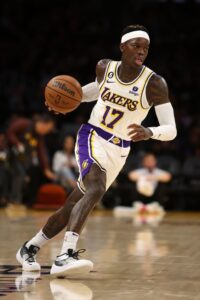 Before the 2022/23 season started, Schröder said he had “
Before the 2022/23 season started, Schröder said he had “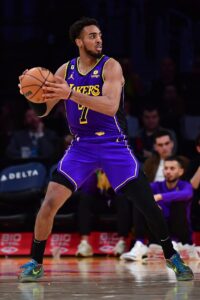 There’s nothing about Brown’s game that really jumps out at you, nor do his modest numbers — he’s averaging 7.3 PPG, 4.1 RPG and 1.2 APG in 70 games (45 starts, 24.9 MPG).
There’s nothing about Brown’s game that really jumps out at you, nor do his modest numbers — he’s averaging 7.3 PPG, 4.1 RPG and 1.2 APG in 70 games (45 starts, 24.9 MPG).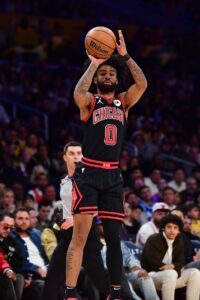
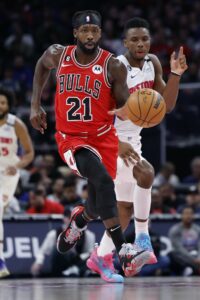 Beverley’s free agency situation is strange. On one hand, the Bulls have gone 10-5 with him in the starting lineup – a very good mark, particularly for a team that has been wildly inconsistent in 2022/23.
Beverley’s free agency situation is strange. On one hand, the Bulls have gone 10-5 with him in the starting lineup – a very good mark, particularly for a team that has been wildly inconsistent in 2022/23.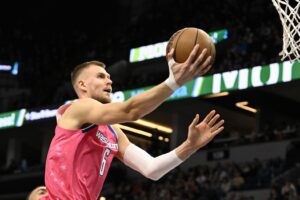
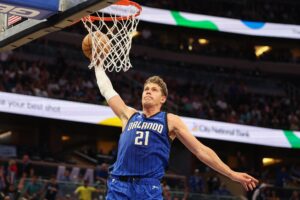 Part of the reason Orlando was comfortable trading
Part of the reason Orlando was comfortable trading 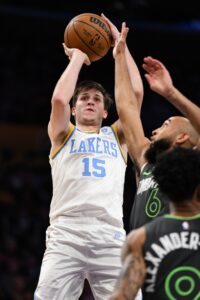 After going undrafted out of Oklahoma in 2021, Reaves initially caught on with the Lakers on a two-way deal, but received a promotion to a standard contract before his rookie season started. He was one of the bright spots in an otherwise disappointing season in Los Angeles, averaging 7.3 PPG, 3.2 RPG and 1.8 APG on .459/.317/.839 shooting (.600 true shooting percentage) in 61 games (23.2 MPG).
After going undrafted out of Oklahoma in 2021, Reaves initially caught on with the Lakers on a two-way deal, but received a promotion to a standard contract before his rookie season started. He was one of the bright spots in an otherwise disappointing season in Los Angeles, averaging 7.3 PPG, 3.2 RPG and 1.8 APG on .459/.317/.839 shooting (.600 true shooting percentage) in 61 games (23.2 MPG).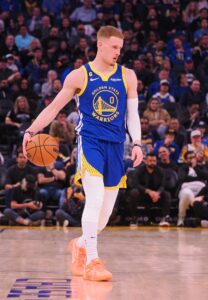 I was very surprised at how relatively little money DiVincenzo received in his first free agency foray last summer. I know he was coming off a down season in ’21/22 following left ankle surgery and had particularly struggled with his shot – he posted a .351/.339/.843 shooting line in 42 combined games (24.0 MPG) with Milwaukee and Sacramento (.510 TS%).
I was very surprised at how relatively little money DiVincenzo received in his first free agency foray last summer. I know he was coming off a down season in ’21/22 following left ankle surgery and had particularly struggled with his shot – he posted a .351/.339/.843 shooting line in 42 combined games (24.0 MPG) with Milwaukee and Sacramento (.510 TS%).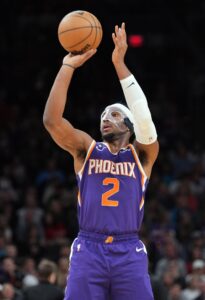 Okogie spent his first four seasons with Minnesota, the team that drafted him 20th overall in 2018. They let him walk after his rookie deal expired, and the 24-year-old was only able to find a veteran’s minimum deal with Phoenix.
Okogie spent his first four seasons with Minnesota, the team that drafted him 20th overall in 2018. They let him walk after his rookie deal expired, and the 24-year-old was only able to find a veteran’s minimum deal with Phoenix.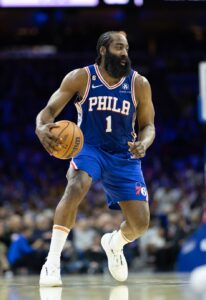 Harden started to look a little old and out of shape in 2021/22, never quite recovering from a reoccurring hamstring injury originally sustained in late ‘20/21.
Harden started to look a little old and out of shape in 2021/22, never quite recovering from a reoccurring hamstring injury originally sustained in late ‘20/21.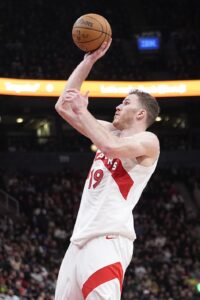 Acquired in a deadline deal with San Antonio, Poeltl has gotten off to a great start in his second stint with Toronto, looking very motivated in averaging 14.9 PPG, 9.2 RPG, 2.5 APG, 1.8 SPG and 1.7 BPG while shooting 69% from the floor and 56.1% from the free throw line through 12 games (28.4 MPG).
Acquired in a deadline deal with San Antonio, Poeltl has gotten off to a great start in his second stint with Toronto, looking very motivated in averaging 14.9 PPG, 9.2 RPG, 2.5 APG, 1.8 SPG and 1.7 BPG while shooting 69% from the floor and 56.1% from the free throw line through 12 games (28.4 MPG).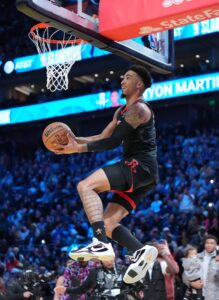 The No. 52 overall pick of the 2020 draft, Martin is averaging career highs with 12.0 PPG and 5.6 RPG while shooting a career-best 56.2% from the field through 65 games (26.9 MPG). The high flier is another player who saw his name mentioned in trade rumors early in the season, but obviously Houston decided to keep him.
The No. 52 overall pick of the 2020 draft, Martin is averaging career highs with 12.0 PPG and 5.6 RPG while shooting a career-best 56.2% from the field through 65 games (26.9 MPG). The high flier is another player who saw his name mentioned in trade rumors early in the season, but obviously Houston decided to keep him.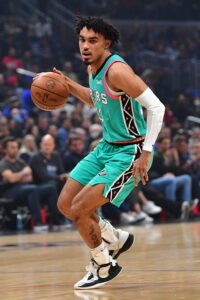 The No. 41 overall pick of the 2020 draft, Jones rarely saw the court in his first season, appearing in 37 games with an average of 7.3 MPG. He saw more action last season, but he was still limited to a reserve role, appearing in 69 games with averages of 6.0 PPG and 3.4 APG in 16.6 MPG.
The No. 41 overall pick of the 2020 draft, Jones rarely saw the court in his first season, appearing in 37 games with an average of 7.3 MPG. He saw more action last season, but he was still limited to a reserve role, appearing in 69 games with averages of 6.0 PPG and 3.4 APG in 16.6 MPG.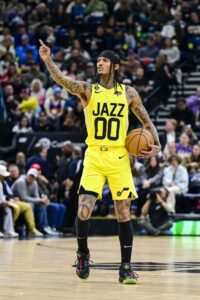 Clarkson is expected to decline his player option to land a long-term contract in free agency, which makes a lot of sense. He’s averaging career highs in points (20.8) and assists (4.4) per game and has matched his career best in rebounds per night (4.0) while posting a .444/.338/.816 shooting slash line (.558 true shooting percentage).
Clarkson is expected to decline his player option to land a long-term contract in free agency, which makes a lot of sense. He’s averaging career highs in points (20.8) and assists (4.4) per game and has matched his career best in rebounds per night (4.0) while posting a .444/.338/.816 shooting slash line (.558 true shooting percentage).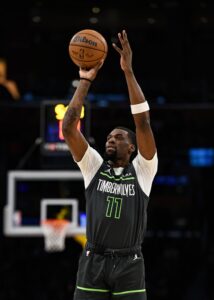 Reid’s per 36 numbers have been quite consistent in each of his four seasons. So why is his stock up?
Reid’s per 36 numbers have been quite consistent in each of his four seasons. So why is his stock up?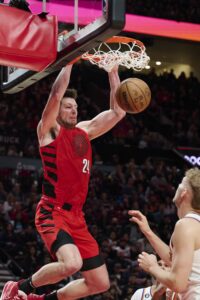 Another player on a minimum-salary deal, Eubanks plays within a clearly defined, limited offensive role of setting hard screens, rolling for the occasional lob, and crashing the offensive glass. His averages of 6.1 points, 5.1 rebounds and 1.2 blocks don’t exactly jump off the page, though he is shooting an impressive 68.3% from the field through 62 games (19 starts, 19.9 minutes).
Another player on a minimum-salary deal, Eubanks plays within a clearly defined, limited offensive role of setting hard screens, rolling for the occasional lob, and crashing the offensive glass. His averages of 6.1 points, 5.1 rebounds and 1.2 blocks don’t exactly jump off the page, though he is shooting an impressive 68.3% from the field through 62 games (19 starts, 19.9 minutes).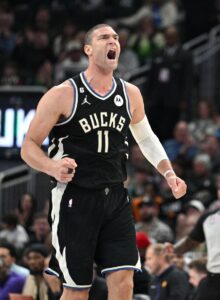 Lopez has been one of the NBA’s best stories this season, rebounding from a mostly lost season in 2021/22 after undergoing back surgery (he played just 13 regular season games and 12 playoff games). He’s having an outstanding year and has been a major factor in Milwaukee’s league-leading 44-17 record, averaging 14.7 PPG, 6.7 RPG and 2.4 BPG on .508/.370/.766 shooting through 60 games (30.3 MPG).
Lopez has been one of the NBA’s best stories this season, rebounding from a mostly lost season in 2021/22 after undergoing back surgery (he played just 13 regular season games and 12 playoff games). He’s having an outstanding year and has been a major factor in Milwaukee’s league-leading 44-17 record, averaging 14.7 PPG, 6.7 RPG and 2.4 BPG on .508/.370/.766 shooting through 60 games (30.3 MPG).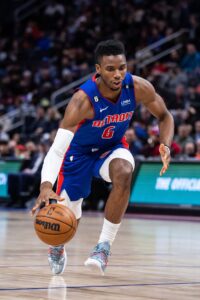 Diallo is challenging to evaluate because his strengths and weakness are more pronounced than most players. He is a non-shooting wing with pretty bad tunnel vision, which you would expect would make him ineffective in a league constantly looking for floor-spacers.
Diallo is challenging to evaluate because his strengths and weakness are more pronounced than most players. He is a non-shooting wing with pretty bad tunnel vision, which you would expect would make him ineffective in a league constantly looking for floor-spacers.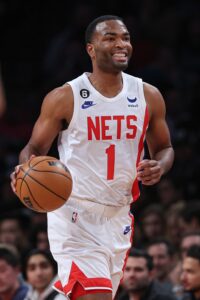 2022/23: $2,628,597
2022/23: $2,628,597